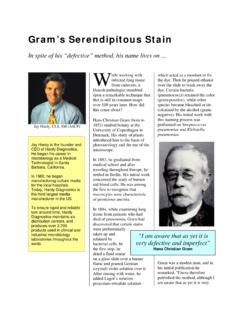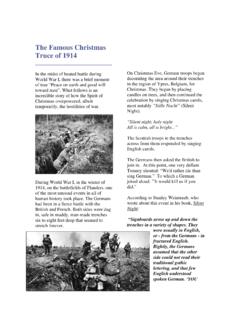Transcription of Nomenclature of Microorganisms - Hardy Diagnostics
1 Naming Conventions by Jay Hardy CLS(ASCP), SM(NRM). Nomenclature of Microorganisms The Origin of Names The Greek philosopher Aristotle attempted to classify all living things as either Plant or Animal. He grouped animals into Land Dwellers, Water Dwellers, and Air Dwellers. Although this system made sense to Aristotle, we would have a difficult time in grouping elephants and earthworms, whales and water striders, flies and falcons together. Subsequent scientists later tried to classify living creatures by means of locomotion, grouping butterflies and bats (flying), barnacles and barley (both rooted in place). This system of classification was obviously flawed as well. The efforts to classify living things saw great progress in the work of Carl Linnaeus, a Swedish botanist. He developed his naming system in the middle 1700's, which essentially the same one we use today.
2 He attempted to name all known plants, animals, and minerals using Latin and Greek names. One of his books, Systema Naturae, meaning The Natural Classification", was published in 1735 and was based on his religious belief that one could understand God by studying his creation. Today, microorganism names originate from four different sources: 1. Descriptive For example Staphylococcus aureus (grape-like cluster of spheres, golden in color), Streptococcus viridans (chains of spheres, green in colony color), Proteus vulgaris (first and common), Helicobacter pylori (spiral shaped rod at the entrance to the duodenum). 2. Scientist's names , Escherichia coli (Theodor Esherich), Erlichia (Paul Erlich), Nessieria (Albert Neisser), Listeria (Joseph Lister), Pasturella (Louis Pasteur), Yersinia (AlexandreYersin), Bartonella (Alberto Barton), Morganella (H.)
3 De R. Morgan), Edwardsiella (P. R. Edwards). 3. Geographic places , Legionella longbeachiae (Long Beach, California), Pasturella tularensis (Tulare County, California), Pseudomonas fairmontensis (Fairmount Park, pennsylvania ), Mycobacterium genavense (Geneva, Switzerland), Blastomyces brasiliensis (Brazil), Providencia spp. (Brown University, Providence, RI). 4. Organizations , Legionella ( american legion ), Afipia felis (Air Force Institute of Pathology), Cedecea spp. (Centers for Disease Control), Bilophila wadsworthia (VA Wadsworth Medical Center in Los Angeles). Taxonomy Kingdom ( american system has six: Animalia, Plantae, Fungi, Protista, Archaea, Bacteria). Phylum (there are 23+ bacterial phyla). Class Order Family Genus (aka, generic name). Species (aka, specific name, specific epithet). Subspecies For example, the bacteria used in yogurt production would be classified as follows.
4 Kingdom: Bacteria Phylum: Firmicutes Class: Bacilli Order: Lactobacillales Family: Lactobacillaceae Genus: Lactobacillus Species: L. delbrueckii Subspecies: L. d. bulgaricus Rules of Nomenclature 1. Use Binary Names - Binary names (invented by Known as the Father of Modern Linnaeus), consisting of a generic name and a species Taxonomy Carl Linnaeus was the first to consistanly name plants and animals epithet ( , Escherichia coli), must be used for all using the binomial system of Latin Microorganisms . Names of categories at or above the genus names for genus and species. level may be used alone, but species and subspecies names (species names) may not. In other words never use a species name alone. 2. When to Capitalize The genus name (and above) is always capitalized, the species name is never capitalized, Bacillus anthracis 3. When to Italicize - Names of all taxa (kingdoms, phyla, classes, orders, families, genera, species, and subspecies) are printed in italics and should be underlined if handwritten; strain designations and numbers are not.
5 If all the surrounding text is italic, then the binary name would be non-italic (Roman typeface) or underlined ( A common cause of diarrhea is E. coli 0157, a gram negative bacillus). 4. When to use Initials - A specific epithet must be preceded by a generic name, written out in full the first time it is used in a paper. Thereafter, the generic name should be abbreviated to the initial capital letter ( , E. coli), provided there can be no confusion with other genera used in the paper. Be careful with the S words; Salmonella, Shigella, Serratia, Staphylococcus, Streptococcus, etc. 5. Common Names - Vernacular (common) names should be in lowercase roman type, non- italic ( , streptococcus, brucella). However when referring to the actual genus name (or above). always capitalize and italicize. 6. Subspecies and Serovars - For Salmonella, genus, species, and subspecies names should be rendered in standard form: Salmonella enterica at first use, S.
6 Enterica thereafter;. Salmonella enterica subsp. arizonae at first use, S. enterica subsp. arizonae thereafter. Names of serovars should be in roman type with the first letter capitalized: Salmonella enterica serovar Typhimurium. After the first use, the serovar may also be given without a species name: Salmonella serovar Typhimurium. 7. Abbreviations for Species use sp. for a particular species, spp. for several species ( spp stands for species plural ). These abbreviations are not italicized; Clostridium sp. or Clostridium spp. Other Abbreviations: meaning 'for example' (it comes from the Latin, exempli gratia). meaning 'that is' (from the Latin id est). Note that ' ' specifies particular things, whereas ' ' gives examples. etc. meaning 'and so forth' (from the Latin et cetera) [Some people, wrongly, write ect.]. et al. meaning 'and others' (from the Latin et alia).
7 You would use this only when citing references. 8. Plural Forms Plural of genus is genera Plural of species (sp.) is species (spp.). Plural of medium is media (never say this culture media ). Plural of fungus is fungi Plural of streptococcus is streptococci (staphylococcus - staphylococci; enterococcus - enterococci, etc). Plural of bacillus is bacilli Plural of bacterium is bacteria Plural of alga is algae Plural of protozoan is protozoa 9. Listing References Always use the Journal of Clinical Microbiology as a guideline. List the authors (in bold), publication date, name of article, name of journal, volume (in bold), then pages. For example: 1. Agouridas, C., A. Bonnefoy, and J. F. Chantot. 1997. Antibacterial activity of RU 64004 (HMR 3004), a novel ketolide derivative active against respiratory pathogens. Antimicrob. Agents Chemother.
8 41:2149-2158. 2. Angot, P., M. Vergnaud, M. Auzou, R. Leclercq, and Observatoire de Normandie du Pneumocoque. 2000. Macrolide resistance phenotypes and genotypes in French clinical isolates of Streptococcus pneumoniae. Eur. J. Clin. Microbiol. Infect. Dis. 19:755-758. Additional rules: List your sources in an alphabetical order according to the author's last name. If no author is listed, begin with the main word of the article or book title (ignoring A, An, or The). Underline or italicize the title of books or magazines. 10. O vs. 0 Mind your O's and zeros. It is E. coli O157, not E. coli 0157. Question for the Ages: When referring to filamentous fungi .Is it MOLD or MOULD? Hint: it depends on which side of the Atlantic you are on. Common Latin and Greek roots used in Microbiology brevis - short bronch- windpipe a-, an- not, without bucc- cheek, mouth, cavity ab-, a-, abs- away burs- pouch, purse acr-, acro- height, summit, tip camp- field aer-, aero- air, atmosphere cand- glowing,iridescent albus- white canis - dog, coyote ambi- both, on both sides cap-, -cip-, capt-, -cept- hold, take ampulla- bottle, flask capit-, -cipit- head ana- again, against, back cav- hollow angeion - vessel cen(o)
9 - new ant-, anti- against, opposed to, preventive cephale- head ante-, anti- before, in front of, prior to cephalo- head anth-, antho- flower cervic- relating to the neck, relating to the cervix aqu- water chrom- color archaeo-, archeo- ancient chryso- gold arthr- , arthro- joint clad- branch astr-, astro- star, star-shaped coccus- seed, sphere aur- relating to gold, or gold-colored cochl- shell aureus - golden, gold coin coel- hollow avi- bird crypt- hidden bac- rod-shaped cune- wedge baro- weight, pressure curv- bent basi- at the bottom cyan- blue bi- two deca - ten bio- life derma - skin blast- germ, embryo, bud, cell with nucleus dino- terrible bon(i)- good diplo- double bor- north dorsum - back brach- short echinos, echino- hedgehog, sea-urchin, spiny brachi-, brachio- arm equ- horse brachys, brachy - short erythros, erythro- red brev(i)- brief, short (time).
10 Eu- well meg- great, large exo- outside melan- black, dark falc- sickle mening- membrane fasc- bundle mes- middle felis- cat micr(o)- small ferr- iron mill- thousand flav- yellow min- less, smaller flavus- Golden yellow, light yellow mir- wonder, amazement fort- strong mono- single fruct-, frug- fruit morph- form, shape fulvus- Deep yellow, tawny morpho- shape fung-, funct- do mort- death fusc- dark mur- wall galact- milk mut- change gastr- stomach myx- slime ge(o)- earth nan s- dwarf glabra- smooth, hairless ne(o)- new haem(o)- blood necr(o)- dead haema-, hema - blood nephr- kidney hali-, halio - of the sea, salt neur- nerve heli-, helio- sun nigr- black helico- spiral nov- new hom(o)- same ocul- eye homeo- like odont- tooth hydro- water olig- few hyper- above, over oma- cancer inter- among, between oo- egg intra- within operculum- little cover kil(o)- thousand orth- straight lact- milk oxy- sharp, pointed lat(i)- broad, wide pach- thick leuc(o)-, leuk(o)- white paed- child lig- bind palae-, pale- ancient, old lip(o)- fat pan- panto - all lith(o)- stone pan-, pam- all luc- bright, light ped- child lutea- yellow, saffron-colored ped- foot macr- long pedi - foot macro- long, large pen- almost mamm- breast penia- deficiency medi-, -midi- middle pept- peptic, stomach peri- around sapiens- wise petr- rock sarc(o)






